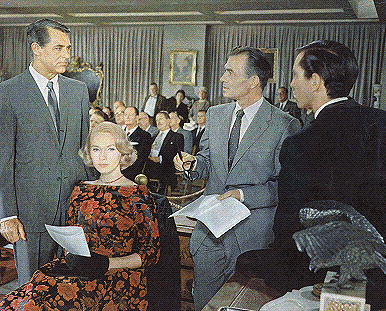North by North West
Simply his best outing as the master of suspense ratchets up the tension in this classic tale from 1959 which starts off using a New York skyscraper as the backdrop to very stylish credits and a roaring Bernard Hermann film score.
It is the tale of mistaken identity, espionage and stolen kisses on an express train heading north, well north west actually. The lead is played by Cary Grant, a Hitch favourite, as advertising executive Roger O Thornhill and his sinister nemesis is the perfectly cast James Mason. Grant’s love interest is Eve Marie Saint, made famous by her appearance in On The Waterfront four years earlier, and she is a great Hitchcock blonde, as the chemistry between her and Grant sizzles and the dialogue, a witty spar, between an actor and actress enjoying each others company as much as the job they have been asked to do.
There are great action scenes and the tension increase as the movie moves from fine set scene to set scene to its iconic finale on top of Mount Rushmore. Just to say there also is a plot device that is about as solid as the “O” in our hero’s name, which we learn early in the movie stands for nothing. A perfect movie for viewing on your own, as a curled up couple on a winter’s nights or sprawled out on a summer evening, or if you can on the big screen with friends.
Masterly sculpted
Vertigo
This comes close, very close to the above and was made only a year earlier. The lead this time is James Stewart who with Grant is an all time favourite actor of mine and Hitchcock liked to cast him as often as possible. Again this film oozes fifties class and sumptuousness and is set in another photogenic town, San Francisco.
Stewart plays a broken cop who is trying to recover from not being able to save a fellow police officer, hence the title of the movie. He is asked by an old college friend, his slick East coast vowels and devilish moustache should be a giveaway, to tail his wife who seems to be having something of nervous breakdown.
Of course, our lonely cop, who does not see that his best friend played by Jessie Royce Landis, later to become the original matriarch of those oil rich Ewings in Dallas, is completely head over heals in love with him. Instead he falls for the icy beauty of Kim Novak’s character.
The film’s premise is can man overcome his deepest fears to save someone he loves? I’ll leave you to find out the answer.
Oh, no Vic, Vic I’m falling.
Psycho
I am putting this in as number three not particularly because I am in love with this film who in their right mind could be? It was a toss up between this and The Birds to represents Hitch’s horror outings but Psycho won because it is important in Hollywood lore and it was a shift by the master from suspense into horror and a final hurrah of a genius who was unfortunately aging. He realised that just as theatre in the UK was turning from well made plays to edgier angrier productions, so was the US film audience. To keep up with a new generation of cinema goers educated on B movie horrors he showed he was still the boss of the film set, studio business and movie distributors by producing a flick that had them jumping out of the seats. Nobody was going to do that again until a big fish with an appetite came along 15 years later. Is it safe to go into the water, is it safe to take a shower?
It is the reason why I usually take a bath.
Jamaica Inn and Rebecca
The master’s “pasty pair”. We’re return to the West coast, but this time it is Britain’s southern-most tip and the home of my mother’s family, so there are personal reasons to put these two films in as well as those of a cineaste. I would recommend you visit the inn which is still there on the bleak Bodmin moor, a savage place rumoured to have its own “beasty”.
Another reason is a change of pace and feel from slick Hollywood to 1930s British studio output. The sets may look flimsier and yes, it is in black and white but it has fine performances by Charles Laughton, one of the true great actors of that decade, and Maureen O’Hara. It is about real pirates too, not based on a Disney ride and a pickled, priapic sexagenarian. A good film then to finish off International Talk Like a Pirate Day, a ha!
Rebecca is a much more of a classic-suspense film, also based on a Daphne Du Maurier novel. She knew things about old Cornish coves.
It is the tale of a newlywed, ‘The Second Mrs DeWinter’ (Joan Fontaine) who finds that the house maid, Mrs Danvers (Judith Anderson) is intensely jealous of her and her marriage to the masterful Maxim de Winter (Lawrence Olivier). Excellent gothic acting all round, especially from Anderson as the scheming Danvers and George Sanders, who plays a barely likeable cad George Sanders.
Quick, call the fire brigade.
Blackmail
This is Hitchcock’s first big hit in the UK and one of the very first British movies to have sound. In fact, there are two versions as many cinemas in 1929 did not have the technology needed for talkies, but the one with dialogue is probably the one you will see. It also has the darker themes of later Hitchcock movies as a police officer tries to pin the blame of a murder on someone else to save his ex-girlfriend.
Oops, wrong bloke sarge.
39 Steps
We move nearly a decade forwards to enjoy this tautest of British thrillers. As with other Hitch movies it involves espionage and mistaken identities and the innocent presumed to be guilty. A murder early on leaves Robert Donnat, playing the intrepid Robert Hannay, another of Britain’s finest screen actors in the 1930s, having to leave the scene of a crime swiftly to find out the meaning of the “39 Steps”. On the way he meets an icy blonde, Madeleine Carroll, on a train, ah “C’est la flee, eh Alfred?”
*For fans of the great TV comedy Dads Army there is an appearance by Private Frasier as an insanely jealous crofter whose wife our hero Hannay attempts to dally with.
The Man Who Knew Too Much
Both versions are fine the first being filmed in 1934 and the second with James Stewart and Doris Day over two decades later. Both have the same rising levels of suspense as the wrongly suspected couples fight to stop an international incident that will have serious diplomatic repercussions, er for those of you who don’t move in an ambassador’s circle or pretend to be reporting on their goings on, war. The ending is a fine musical finale in the Albert Hall.
Cymballic!
Rear Window
This Hitch as the voyeur’s voyeur. James Stewart finely plays our photographer hero LB Jefferies who has to rest at home for weeks as he has broken his leg in a work accident. He is bored out of his mind and his only relief is that he can entertain himself by watching the goings on of his neighbours.
There are vignettes of common ordinary life, a newly wedded couple, Miss Lonely Heart who ends up with several Mr Wrongs and also a long wedded husband and wife who seem to be as cold to each other as the summer weather is hot.
Stewart is ably assisted by Thelma Ritter as his nurse Stella and the oh so glamorous Grace Kelly. One of the truly great screen entrances is generously given to her, but then she had the great beauty to carry it.
The mysterious disappearance of a wife turns LB Jefferies’ (Stewart) tedium into paranoiac overdrive endangering himself and others.
Snap, what a picture
Strangers on a Train
A deal is done between two strangers on a train who will never see each other again. So, what could go wrong? Hitch seems to love setting important scenes on trains; perhaps he luxuriated in their proffered image of romance and elegance, or is it their claustrophobia? Close proximity forcing people forcing to strike up conversations that they would not have usually started.
Fine performances from another Hitchcock favourite Farley Granger, Robert Walker and Ruth Roman and a screenplay that boasted Raymond Chandler as a lead contributor. After four flops it gave the master a huge hit and the base for another decade at the top of his game in Hollywood; if it had failed some great films may never have been made?
Tickets please!







